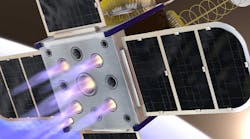CubeSats, those ultra-small satellites roughly the size of a breadbox, give researchers a great low-cost way to put small experiments and sensors into space. They lack only one thing: on-board propulsion. CubeSats are usually taken into space by piggy-backing on a larger rocket whose primary mission is putting a larger, much more expensive satellite into space. If CubeSats had propulsion systems that use common fuels such as hydrazine or compressed gas that are intrinsically dangerous, they would present an unacceptable risk to an organization paying half a billion dollars for the launch services.
To solve this problem, engineers at Los Alamos National Laboratory developed a six-motor array that fits beneath a CubeSat. The motors use a new type of solid-based chemical fuel called a segregated fuel oxidizer. It keeps the solid fuel and oxidizer separate inside the rocket. Mixed fuel-and-oxidizer motors are much more common but much more unstable.
With separate fuel and oxidizers, the motors can burn higher-energy ingredients, and the chemical propulsion generates fast, high-velocity thrust, which is not possible with alternatives such as electrical or compressed-gas motors.
In operation, a pyrotechnic igniter heats the high-nitrogen, high-hydrogen fuel until it begins to burn and releases hydrogen-rich gases. The gases make their way to the oxidizer section and set off a chemical reaction that creates tremendous heat and expanding gasses. These gases exit through a nozzle, creating most of the motor’s thrust.
A six-motor array was recently tested successfully and the team is confident it is close to being able to put an array on a space vehicle to test in space.
“Propulsion would greatly expand the mission-space of these small satellites,” says lead researcher of the project, Bruce Tappan. “It would let CubeSats enter higher orbits or achieve multiple orbital planes in a single mission, and extend mission lifetimes. Another desirable application would be a ‘de-orbiting’ capability.”
NASA currently tracks about half a million pieces of space junk in various orbits around Earth. Soon, small satellites will need to have compelling missions before NASA will let them into space where they clutter things up and present a danger to other satellites. Or they will need to have propulsion that lets them de-orbit, a process in which they accelerate toward Earth and burn up in its atmosphere during re-entry.

